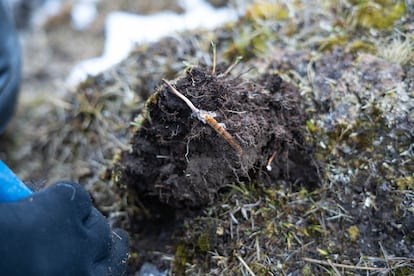The ‘apocalyptic’ fungi from ‘The Last of Us’ is a Himalayan aphrodisiac
‘Cordyceps sinensis’, which is found underground, is a highly valued product in both Tibetan and Chinese medicine. There is evidence that the fungus has been used for more than 2,000 years, and it has been popularized worldwide by the recent television series


Darwin would have tried it. They say that on his voyage aboard the “Beagle,” Charles Darwin threw every exotic animal he found into the pot. Óscar López-Fonseca invites us to explore the world cuisine with culinary experiences that the father of the theory of evolution would surely have ventured to try on that trip.
***
Every country has a food, drink, or plant extract with the supposed ability to stimulate desire or even improve sexual performance. They are aphrodisiacs, known and consumed since time immemorial, although to date science has not proven the real effectiveness of any of them. Bhutan, the last Himalayan kingdom, is the only state in the world that uses the happiness index of its slightly less than 800,000 inhabitants to measure wealth. It is already known that sex and happiness usually go hand in hand, and in this case, the locals have found their particular libido stimulant in valleys located between 11,500 and 16,500 feet above sea level, just a little below the so-called permanent snow line. There the Bhutanese dig the ground in search of Cordyceps sinensis, a parasitic fungus that infects insects and that will be familiar to more than a few people from the video game and television series The Last of Us. Both portray an apocalyptic world in which humans become zombies when they are infected by this very peculiar organism.
However, neither the Cordyceps sinensis — which in Bhutan they call yartsa goenbub, which translates to something like “summer grass winterworm” — nor any other fungus of the same family really pose any risk to human beings, despite what the television scriptwriters say. But they are deadly for some insects. In this case, for the larvae of a type of moth present in this area of Asia. Once infected with its spores, the fungus parasitizes the caterpillars underground and robs them of all their nutrients until they literally dry out and die. Subsequently, the Cordyceps sinensis deploys a filament between three and 10 centimeters from the animal’s head to rise to the surface and continue its life cycle. That’s when man comes into action. The Bhutanese come in search of the filaments between April and August and dig them up for the important additional income they bring. The fungus is a highly valued product in both Tibetan and Chinese medicine, where there is evidence of its use for more than 2,000 years.
Those who praise these supposed benefits claim that it helps prevent diabetes, reduces the risk of dementia, has antidepressant effects, and strengthens the immune system, in addition to increasing vitality and reducing cholesterol. But along with these supposed health benefits, Cordyceps sinensis is also reputed to feed men’s and women’s libido. This has made it a national aphrodisiac in a country where one of the famed religious figures is Drukpa Kunley. The Tibetan Buddhist monk lived between the 15th and 16th centuries and was known as “The Divine Fool” for his love of wine, sexually satisfying women and showing off his virile member in public. In his memory, numerous homes in the country have their doors flanked with drawings of penises in full ejaculation. The Bhutanese claim that they scare away evil spirits and attract fertility.
The mushroom is sold in Bhutan in an endless number of formats, from capsules with containing an extract to the fungus itself, along with the mummified larva to be used as an ingredient in all types of recipes, such as meat stews, or to add to the local beer, chhaang. If taken raw, the locals say it has a sweet flavor with earthy hints and a bitter final aftertaste. Within this culinary versatility, the size of the filament gains importance. The larger the larva — those that retain the reddish eye and the rings on the body are considered to be of superior quality — the higher the price. Those classified as the superior category, which weigh around 0.012 ounces, are priced at $1,818 per ounce.
However, there are cheaper formats to give yourself the pleasure of trying the much sought-after fungus, such as infusions in which the supposed aphrodisiac (at a percentage of 0.5%) is mixed with green tea from neighboring India and packaged paper sachets to put in hot water. The color of the resulting drink is slightly brownish and the flavor does not differ from any green tea since the flavor provided by Cordyceps sinensis is very subtle. The Bhutanese recommend that, to obtain the supposed health and libido benefits, you do not add milk or sugar, and if you want to sweeten it, do it with a small spoonful of honey or soften it with fresh mint leaves. The box contains 25 bags and, despite following the instructions, I am still waiting for the results.
Sign up for our weekly newsletter to get more English-language news coverage from EL PAÍS USA Edition
Tu suscripción se está usando en otro dispositivo
¿Quieres añadir otro usuario a tu suscripción?
Si continúas leyendo en este dispositivo, no se podrá leer en el otro.
FlechaTu suscripción se está usando en otro dispositivo y solo puedes acceder a EL PAÍS desde un dispositivo a la vez.
Si quieres compartir tu cuenta, cambia tu suscripción a la modalidad Premium, así podrás añadir otro usuario. Cada uno accederá con su propia cuenta de email, lo que os permitirá personalizar vuestra experiencia en EL PAÍS.
¿Tienes una suscripción de empresa? Accede aquí para contratar más cuentas.
En el caso de no saber quién está usando tu cuenta, te recomendamos cambiar tu contraseña aquí.
Si decides continuar compartiendo tu cuenta, este mensaje se mostrará en tu dispositivo y en el de la otra persona que está usando tu cuenta de forma indefinida, afectando a tu experiencia de lectura. Puedes consultar aquí los términos y condiciones de la suscripción digital.
More information
Últimas noticias
Most viewed
- Sinaloa Cartel war is taking its toll on Los Chapitos
- Oona Chaplin: ‘I told James Cameron that I was living in a treehouse and starting a permaculture project with a friend’
- Reinhard Genzel, Nobel laureate in physics: ‘One-minute videos will never give you the truth’
- Why the price of coffee has skyrocketed: from Brazilian plantations to specialty coffee houses
- Silver prices are going crazy: This is what’s fueling the rally










































